Download Pdf [2,03 MB] - MTU Aero Engines
Download Pdf [2,03 MB] - MTU Aero Engines
Download Pdf [2,03 MB] - MTU Aero Engines
You also want an ePaper? Increase the reach of your titles
YUMPU automatically turns print PDFs into web optimized ePapers that Google loves.
“Our focus is on longevity of the product and<br />
we’re continuously enhancing it to benefit<br />
our customers,” Müllenholz emphasizes.<br />
After the V2500-A1 version had been improved<br />
to become the V2500-A5, the<br />
SelectOne standard constitutes another<br />
step forward. The V2500-A5 is designed to<br />
suit the varying requirements of the A320<br />
family of aircraft; in the 22,000- to 33,000pound<br />
thrust range, there are seven versions<br />
in total. Thanks to its cost effectiveness, reliability<br />
and environmental credentials, the<br />
V2500 has, from its inception, been the<br />
engine of choice for this Airbus family.<br />
<strong>MTU</strong>’s role in the V2500 program is the fivestage,<br />
low-pressure turbine, which is assembled<br />
at <strong>MTU</strong> Maintenance Berlin-Brandenburg.<br />
As co-founder of the multinational IAE<br />
engine consortium, the German company is<br />
holding a roughly 11-percent stake in the<br />
V2500. Pratt & Whitney contributes the combustor<br />
and the high-pressure turbine, Rolls-<br />
Royce is responsible for the high-pressure<br />
compressor, and Japanese <strong>Aero</strong> <strong>Engines</strong><br />
Corporation for the fan and low-pressure<br />
compressor.<br />
“The modifications embodied in SelectOne,<br />
as compared with the standard V2500-A5<br />
version, mainly involve the high-pressure<br />
compressor and turbine, as well as the electronic<br />
engine control,” explains <strong>MTU</strong>’s<br />
Stephan Krinner, V2500 technical program<br />
engineer. The optimized high-pressure com-<br />
Testing of the SelectOne on the wing of a Boeing 747 in Plattsburgh, New York.<br />
pressor now boasts 3D airfoil geometries as<br />
well as improved aerodynamics and airfoil<br />
surface texture. The high-pressure turbine incorporates<br />
new materials and sealing systems.<br />
<strong>MTU</strong> has adapted its low-pressure turbine<br />
accordingly. “Our specialists optimized the<br />
airfoil angle of attack of the stage three turbine<br />
stator,” explains Werner Striegl, the<br />
V2500 technical program manager. The<br />
German engine manufacturer not only shares<br />
in the development and manufacture of<br />
SelectOne but, as the globally leading<br />
V2500 maintenance provider, also assumes<br />
full repair responsibility.<br />
Before the modified engine was allowed to<br />
fly, it needed to demonstrate its reliability on<br />
the test stand. During the preliminary phase,<br />
three engine tests were on the agenda: the<br />
performance operability test took place in<br />
April 2007 at <strong>MTU</strong>’s Munich facility to verify<br />
the functionality of the complete SelectOne<br />
engine. “For flight approval, we simulated<br />
cycles on the test stand,” explains Kurt<br />
Scheidt, who at <strong>MTU</strong> is responsible for commercial<br />
engine testing. “A cycle lasts 10 to<br />
15 minutes, as we’re mainly testing at the<br />
maximum loads occurring during takeoff and<br />
landing.” Upon completion of several weeks<br />
of test stand trials, the engine was stripped<br />
and inspected. Additionally, a telemetry test<br />
and an endurance test took place in the U.S.<br />
at partner Pratt & Whitney’s test facility.<br />
After the ground testing wrapped up successfully<br />
in October 2007, the engine was<br />
flown to America in the cargo bay of a commercial<br />
transport. At Plattsburgh in New<br />
York State, testing on the flying testbed was<br />
scheduled. On the wing of a Boeing 747, the<br />
IAE engine completed 45 flying hours in<br />
seven flights and proved to be in perfect<br />
shape. “The targets were all met and the performance<br />
capabilities attested to in the<br />
ground runs were confirmed,” Scheidt summarizes.<br />
The technically difficult installation<br />
of the test engine for the flight trials was<br />
assisted by <strong>MTU</strong> instrumentation specialists<br />
on-site. 500 tapping points needed to be<br />
crammed into the engine, no easy job even<br />
for the experts. Says Scheidt: “The whole<br />
complex sensor system had to be accommodated<br />
in a manner such that it was sure not<br />
to interfere with flightworthiness.”<br />
The meticulously accurate preparations made<br />
by all involved paid off: Following successfully<br />
completed flight testing, SelectOne obtained<br />
approval from the U.S. Federal Aviation<br />
Administration (FAA) in December 2007.<br />
But that left the partners little time to relax;<br />
already in February this year SelectOne<br />
underwent further flight trials, this time in<br />
the sky above Toulouse in the south of<br />
France, on the wing of an Airbus A320.<br />
“We’re right on schedule,” Scheidt explains.<br />
Certification by the European authorities is<br />
expected in May this year, in time for the ILA<br />
International <strong>Aero</strong>space Exhibition in Berlin.<br />
That paves the way for launching production<br />
in summer. IAE’s first SelectOne production<br />
engine will go to IndiGo Airlines. The<br />
Indian carrier will be equipping a hundred<br />
Airbus A320 family aircraft with the<br />
SelectOne build standard, becoming the<br />
launch customer of the optimized bestseller.<br />
For additional information, contact<br />
Leo Müllenholz<br />
+49 89 1489-3173<br />
For interesting multimedia services<br />
associated with this article, go to:<br />
www.mtu.de/108V2500_E<br />
The SelectOne on <strong>MTU</strong> <strong>Aero</strong> <strong>Engines</strong>’ test facility in Munich. In February 2008 the SelectOne made its first flight in Toulouse – on the wings of an A320.<br />
10 Technology + Science<br />
11


![Download Pdf [2,03 MB] - MTU Aero Engines](https://img.yumpu.com/11154858/6/500x640/download-pdf-203-mb-mtu-aero-engines.jpg)


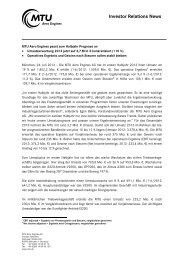
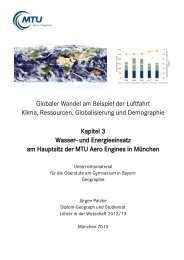
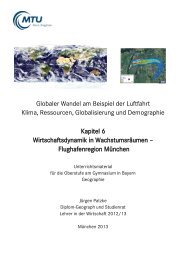
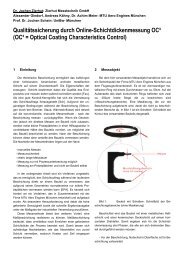
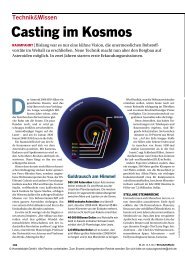

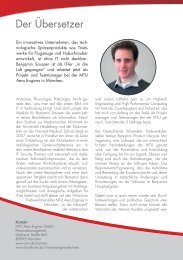
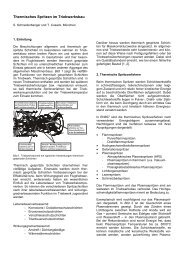
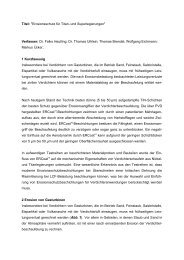


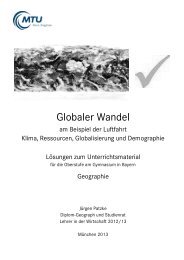
![Download PDF [5,37 MB] - MTU Aero Engines](https://img.yumpu.com/21945461/1/190x125/download-pdf-537-mb-mtu-aero-engines.jpg?quality=85)